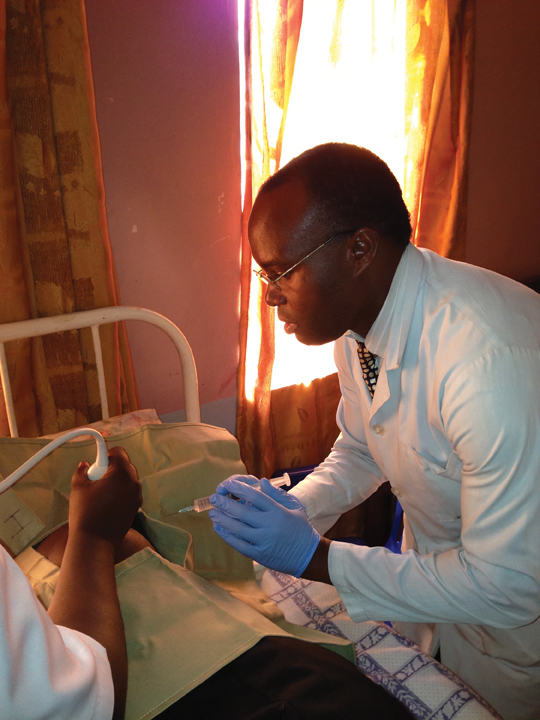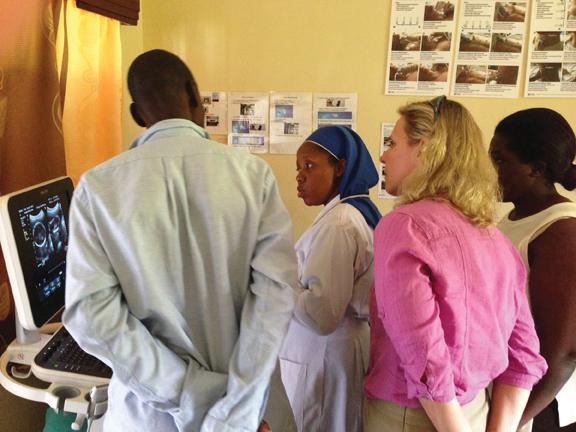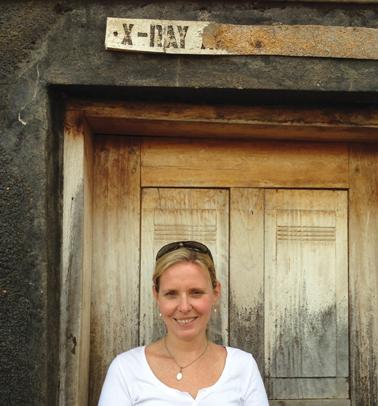
Alphonsus Matovu, M.D., at Kamuli Mission Hospital, begins the first-ever ultrasound-guided breast biopsy performed at this rural site in Uganda.
Imaging the World (ITW) was founded in 2008. Its mission is to bring medical expertise and high-quality, low-cost health care to most remote and under-served areas worldwide by integrating simple ultrasound technology with training, local capacity building and community support. It is much more than modern technology alone — it is a system solution.
What is the Problem?
According to the United Nations Children’s Fund, for every 1,000 live births, at least 63 infants die before their first birthday in Uganda. Many of those deaths are due to complications that could have been predicted by ultrasound technology. The situation also contributes to the country’s high infant mortality rate, with 310 out of every 100,000 women dying in childbirth, and is the leading cause of death for girls ages 15–18.
Globally, complications from pregnancy and birth contribute to more than 358,000 maternal deaths annually. The majority of these deaths occur in developing nations where there is limited access to even basic healthcare. And most of these deaths are preventable with basic obstetrical imaging.
How Did You Become Involved?
After long days performing ultrasound exams on the border of Kenya and Sudan while investigating a parasitic disease as part of a research team in the early 1990s, I would join my colleagues in an impromptu health clinic, conducting physical exams. Each day, we found that by using ultrasound we were able to discover potentially dangerous conditions, such as breech presentation, multiples or placenta previa in late pregnancy.
As a result, we were able to counsel patients to get to a healthcare facility where they could get appropriate, lifesaving treatment in time. This made me wonder how one could make ultrasound accessible to people in need in the most remote areas of the world; but at that time, the lack of resources and trained personnel in areas like this made it impossible to make diagnostic imaging available for critical diagnoses; and I knew that traditional methods of ultrasound outreach were simply not sustainable to make a difference for the community in the long-term.
What was the “Aha” Moment?
Over the years, I considered the problem of bringing a permanent ultrasound solution to the most rural areas of the world, but it wasn’t until 2007, when I began working with Brian Garra, M.D., that a solution came to light.
He had been promoting volume scans for ultrasound diagnosis since 2001, and proposed that they use entirely new ultrasound protocols using volume scanning to reduce the extent of operator training needed while still maintaining high diagnostic quality.
We were able to show that ultrasound volume imaging is not only safe, effective, reproducible and repeatable, but that the images obtained could be compressed and decompressed for image transmission over a regular cell phone network for remote interpretation without loss of diagnostic quality. Working together, Garra and I started an organization to distribute this unique technology worldwide and Imaging the World was founded.
Why Does it Work?
Through a state-of-the-art data compression and transmission system, the images are sent via the internet to a secure server where they can be accessed and “read” on a McKesson PACS from anywhere in the world. Within hours, rural health center workers receive potentially lifesaving diagnoses by phone or text message, offering options for treatment.
ITW’s solution can only be as successful as it is adaptable. The ITW platform is designed for maximum flexibility, so it can be adapted to widely divergent cultures and healthcare systems. Through collaboration with local governments and healthcare providers, and through community outreach initiatives, imaging care is seamlessly integrated to improve health and save lives. ITW’s low-cost, sustainable and scalable imaging model is possible anywhere cell phone signals are available.
What is Next?
We are very excited about our newest initiative — an interdisciplinary team from Uganda and around the world just launched a pilot breast cancer detection program in rural Uganda. Through a Grand Challenges Canada Stars in Global Health grant, awarded to Imaging the World Africa (ITWA) and directed by Ugandan surgeon Alphonsus Matovu, M.D., Imaging the World is able to help experts bring high-quality and cost-effective breast cancer detection to remote, underserved areas. Breast diagnostic ultrasound can be performed using the same methodology that has been successful for ITW in obstetric ultrasound.
How Can Others Become Involved?
ITW collaborates with ultrasound industry partners and imaging informatics industry experts such as McKesson and peerVue, as well as other radiology and medical organizations, ultrasound education specialists and academic institutions. It continues to seek support and volunteers for a number of functions. For more information: www.imagingtheworld.org
Case study supplied by McKesson Corp.




 December 10, 2025
December 10, 2025 









